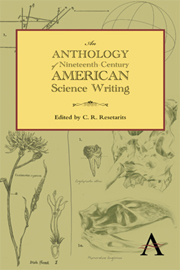Book contents
- Frontmatter
- Contents
- Preface
- Part One 1800–1846 Naturals and Naturalists
- Part Two 1846–1876 Warriors
- Part Three 1876–1900 Scientists
- Part Three Introduction
- “The Fixation of Belief” (excerpt), Popular Science Monthly (1877)
- “How to Make Our Ideas Clear” (excerpt) Popular Science Monthly (1878)
- “Catastrophism and Evolution” (excerpt), The American Naturalist (1877)
- “The Spectrum of an Argand Burner,” Science (1883)
- “The New Astronomy. I. Spots on the Sun” (excerpt), The Century (1885)
- “Screw,” Encyclopedia Britannica, vol. 21, 9th edition (1875–1889)
- “On the Relative Motion of the Earth and the Luminiferous Ether,” American Journal of Science (1887)
- “The Lake as a Microcosm” (excerpt), Bulletin of the Peoria Scientific Association (1887)
- “Laws of Temperature Control of the Geographic Distribution of Terrestrial Animals and Plants,” National Geographic Magazine (1894)
- “The Ecological Relations of the Vegetation on the Sand Dunes of Lake Michigan” (excerpt), Botanical Gazette (1899)
- “On the Equilibrium of Heterogeneous Substances, abstract,” American Journal of Science and Arts (1878)
- Bibliography
“The Ecological Relations of the Vegetation on the Sand Dunes of Lake Michigan” (excerpt), Botanical Gazette (1899)
from Part Three - 1876–1900 Scientists
Published online by Cambridge University Press: 05 June 2012
- Frontmatter
- Contents
- Preface
- Part One 1800–1846 Naturals and Naturalists
- Part Two 1846–1876 Warriors
- Part Three 1876–1900 Scientists
- Part Three Introduction
- “The Fixation of Belief” (excerpt), Popular Science Monthly (1877)
- “How to Make Our Ideas Clear” (excerpt) Popular Science Monthly (1878)
- “Catastrophism and Evolution” (excerpt), The American Naturalist (1877)
- “The Spectrum of an Argand Burner,” Science (1883)
- “The New Astronomy. I. Spots on the Sun” (excerpt), The Century (1885)
- “Screw,” Encyclopedia Britannica, vol. 21, 9th edition (1875–1889)
- “On the Relative Motion of the Earth and the Luminiferous Ether,” American Journal of Science (1887)
- “The Lake as a Microcosm” (excerpt), Bulletin of the Peoria Scientific Association (1887)
- “Laws of Temperature Control of the Geographic Distribution of Terrestrial Animals and Plants,” National Geographic Magazine (1894)
- “The Ecological Relations of the Vegetation on the Sand Dunes of Lake Michigan” (excerpt), Botanical Gazette (1899)
- “On the Equilibrium of Heterogeneous Substances, abstract,” American Journal of Science and Arts (1878)
- Bibliography
Summary
“Part I. Geographical Relations of the Dune Floras”
Introduction
The province of ecology is to consider the mutual relations between plants and their environment. Such a study is to structural botany what dynamical geology is to structural geology. Just as modern geologists interpret the structure of the rocks by seeking to find how and under what conditions similar rocks are formed today, so ecologists seek to study those plant structures which are changing at the present time, and thus to throw light on the origin of plant structures themselves.
Again, ecology is comparable to physiography. The surface of the earth is composed of a myriad of topographic forms, not at all distinct, but passing into one another by a series of almost perfect gradations; the physiographer studies landscapes in their making, and writes on the origin and relationships of topographic forms. The ecologist employs the methods of physiography, regarding the flora of a pond or swamp or hillside not as a changeless landscape feature, but rather as a panorama, never twice alike. The ecologist, then, must study the order of succession of the plant societies in the development of a region, and he must endeavor to discover the laws which govern the panoramic changes. Ecology, therefore, is a study in dynamics. For its most ready application, plants should be found whose tissues and organs are actually changing at the present time in response to varying conditions. Plant formations should be found which are rapidly passing into other types by reason of a changing environment.
- Type
- Chapter
- Information
- An Anthology of Nineteenth-Century American Science Writing , pp. 277 - 284Publisher: Anthem PressPrint publication year: 2012



